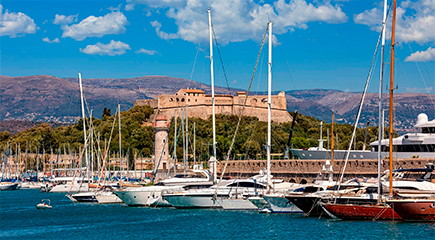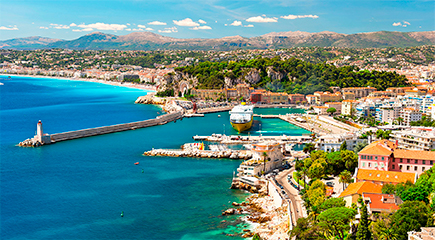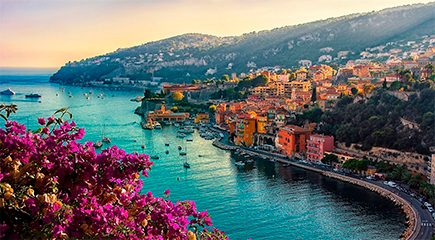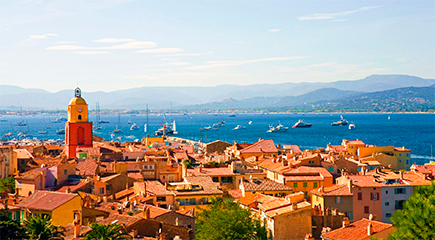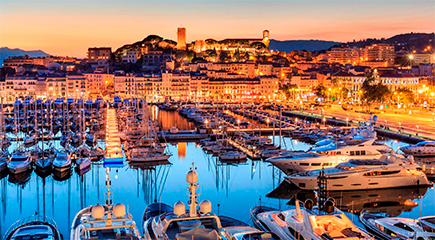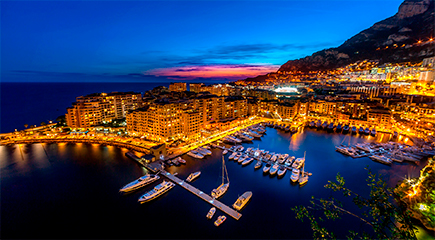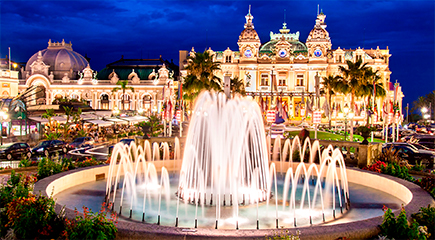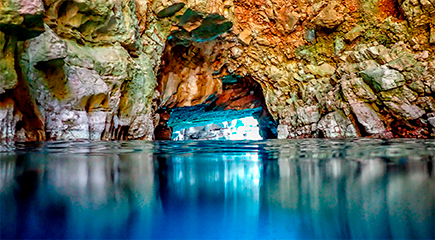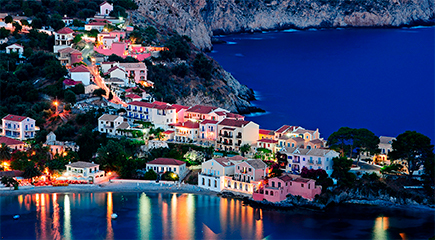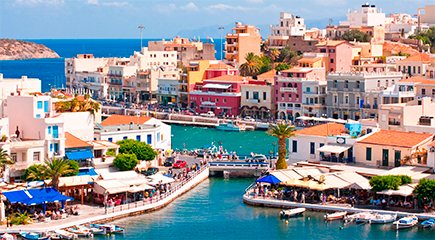-

French Riviera
The Côte d'Azur owes its name to the eponymous work by the French writer Stéphen Liégeard. The phrase was born when he visited the bay at the city of Hyères and was struck by its beauty. The mild climate of the region satisfies the ideal conditions of a beach holiday. Along the coast, there are many resorts. You can try the famous Mediterranean cuisine, which is a bit simpler than the French cuisine but not any less refined, at any town. Those who love to shop definitely won’t be disappointed by the fashionable Riviera boutiques where you can find every brand imaginable. Affluent people come here for luxury shopping. Life on the coast never stops, so after sunset, you can visit multiple distinguished night clubs.
The main yachting routes are along the coastline, which is about 300 kilometres long. Visiting yachtsmen often take time to see the Principality of Monaco, which is famous for its Monaco Yacht Show, the Formula 1 track running through the city streets and, of course, the Casino de Monte-Carlo. From here, you can easily reach Nice, which was the favourite vacation spot of the Russian emperor dynasty Romanov, or Cannes, the elite resort and home of the world-famous film festival and yacht exhibition.
Those pining for a relaxing holiday should definitely visit Antibes as well. This picturesque town captures one’s imagination with its narrow streets intertwined with vines. You can anchor near the centre at the port of Vauban.
Fans of noisy nightlife, shopping and expensive restaurants will be attracted to Saint-Tropez. You can get here by chartering a yacht at Marseille or Cannes. If you like longer routes, you can set off to explore the Italian Riviera or head for the coast of Spain.
-

Corsica
As the most mountainous island in the Mediterranean, Corsica has a second name – a Mountain in the sea. Here, hiking and mountaineering are especially popular among tourists. There are no manufacturing industries in Corsica, which is why the air here is so pure. The clean water and diverse aquatic fauna also make it the perfect place for divers. And don’t forget désert des Agriates – that’s the only desert in Europe!
Sailors, especially, like the Calvi–Sardinia–Saint-Tropez route. From Calvi, the route takes one along the west coast of Corsica. You can take in the sights of the Scandola Nature Reserve with its amazing multicoloured cliffs or by Ajaccio and the Gulf of Valinco. Don’t forget to stop by the small but picturesque town of Propriano. In the villages, under the majestic Alta Rocca massif, the yachties can learn about the ordinary life of the local residents. A little further, the course takes you through Bonifacio and the southernmost point of France, the island of Lavezzi, which is also a great spot for diving. From here, through La Maddalena and the island of Elba, you can get to the final point – Saint-Tropez.
However, there are shorter routes as well. For example, sailors often take a boat at Ajaccio or Bonifacio and go on to enjoy the scenic landscapes of Sardinia. From Corsica, you can also get to mainland Italy and visit its historical centre – Rome.
-

Croatia
Located in the central part of the Croatian coast, Dalmatia stretches in a narrow ribbon from the Kvarner Gulf to the Bay of Kotor. About 375 km of beautiful beaches and exceptionally clear sea (the region is the European leader in terms of the number of Blue Flags), more than 1200 picturesque islands and a beautiful coastline deserve the title of the “Mediterranean Fjords”. A practically enclosed water area of the Adriatic Sea, which is framed by mountains on all sides, creates a special microclimate that is perfect for sea holidays.
Among the numerous islands on the Adriatic coast of Croatia, you’ll find half a thousand bays and ports of all sizes and countless number of yacht routes. The region simply has no equal in the number of places suitable for yacht parking. From Zadar, the main city of North Dalmatia, which is famous for its historical monuments, you can make a journey through the waters of the picturesque islands of Pag, Cres, Krk, Rab and Lošinj to the coast of Istria. Consider taking this opportunity to see the largest port in the country, the ancient Rijeka, the old town of Pula, Kvarner Bay, the charming islands of Brijoni, fjord-like Medulin and Lim marinas as well as the Raša bay. You can then turn south and take in the ancient Šibenik, its picturesque Krka fjord bay and the Cathedral of St. James, which is listed in the UNESCO World Heritage List.
Split is the second largest city in Croatia. It is the heart of Central Dalmatia and the home of many important ancient monuments, such as the Diocletian's Palace (III century) and the Peristil Square, which consist of a beautiful complex of medieval buildings.
Visit the first-class city marina, and from there, you can go to the ruins in the city of Salona, the ancient capital of the Roman province of Dalmatia. Don’t ignore the town of Trogir, which is included in the UNESCO World Heritage List, and make a simple sea voyage to the green island of Brač with its numerous bays and nice pebble beaches. Then, you can sail along the coast Makarska Riviera – a series of colourful resort villages overlooking the charming city of Makarska. Then go on to the “Croatian Madeira” – the longest and sunniest island in the Adriatic Hvar – and continue the route past the tiny island of Vis with its famous “blue cave” to the picturesque island of Korčula, which is known for its medieval monuments and curative mud. Then, see for yourself the whole mini-archipelago of the island of Lastovo, which has the status of a natural park.
Dubrovnik, “the Pearl of Croatia," lies in the southern part of the Adriatic coast. The city, which was founded in the 7th century, is the centre of the beautiful Dubrovnik Riviera. It is surrounded by medieval fortified walls with numerous monuments that are included in the UNESCO World Heritage List. The narrow and long Ombla Bay (Rijeka Dubrovačka), the adjacent city port and ACI Marina Dubrovnik are excellent starting points for visiting the island of Lokrum, which is home to a botanical garden, a Benedictine monastery and nudist beaches. The popular Cavtat resort is popular for the numerous ancient ruins found there. One of the best resorts in the region, the green island of Koločep, and the patriarchal islands of Lopud and Šipan are also worth mentioning. The final destination might as well be the wooded island of the Adriatic – Mljet, which is famous for its national park, picturesque marinas of Polače, Pomena and Saplunara, as well as the “Odyssey’s cave”, where, according to legend, the hero of the Homeric epic met the nymph Calypso.
Starting in Dubrovnik, you can make a longer transition to the resort coasts of Montenegro and Greece; from Split, there are many routes to the shores of Italy, Sardinia, Corsica, Malta and the French Riviera.
-

Sardinia
The second largest island in the Mediterranean Sea is the fourth least populated region in Italy with a population density of 66/km2. A little more than 1.6 million people live here. Therefore, in Sardinia, there’s a place for everyone. Sardinia also hosts a developed tourist infrastructure with expensive hotels and nature reserves. Travellers get to enjoy abundant local beaches, the rich history of the island and the unique wildlife on land and in water.
Developed infrastructure attracts yachtsmen, and along the coastline, there are many marinas for every taste and budget. The most modern ones are located on the northern coast, for e.g. in Porto Cervo, but the prices are higher here. But, if you wish, you can always find a naturally protected bay to anchor. The region is also great for holding regattas. The famous Maxi Yacht Rolex Cup and the Sardinian Regatta are held here annually.
Get acquainted with Sardinia by taking a trip around the island. The starting point is often Porto Rotondo, and from there, you can head north along the east coast. You will be able to cover almost all the significant spots during this single voyage. For example, near Alghero, you’ll find the grotto of Neptune – a cave that looks like the palace of a mountain king.
The national park in the La Maddalena archipelago is also worth mentioning. It is very popular among divers. The journey through the island ends on the secluded beaches of the Li Nibani Island, which are ideal for relaxation.
The national park in the La Maddalena archipelago is also worth mentioning. It is very popular among divers. The journey through the island ends on the secluded beaches of the Li Nibani Island, which are ideal for relaxation.
The proximity of Corsica to France opens up the opportunity to get acquainted with the culture of France. From here, you are free to explore the Côte d'Azur with its attractive resorts – Nice, Cannes or Saint-Tropez.
If you want to explore mainland Italy and don’t mind spending a couple of days in the open sea, you could head straight to Rome or Naples from Sardinia.
Sardinia also offers longer routes. If you wish, you can go through Sicily to Malta or to the coast of Greece. Moreover, there’s a clear path from here to Balearics in Spain. Everything is limited only by the traveller’s imagination.
-

Balearics
The Balearic archipelago (Islas Baleares, Illes Balears), consisting five large islands, is located in the western part of the Mediterranean Sea. The mild climate, the longest swimming season in the region, many colourful towns with unique architecture, an abundance of beautiful beaches, a calm sea and developed leisure infrastructure have long turned the islands into one of the most attractive holiday destinations in the Mediterranean.
Almost the entire coast of the archipelago is ideal for sea cruises. After leaving Puerto Portals, Mallorca’s most modern marina, or the famous Port Adriano created by the renowned French architect Philippe Starck, you can visit the most picturesque harbour of the capital – Puerto de Palma. After that, you can sail along the east coast to the cleanest bays of Alcúdia and Pollença, where lie the ruins of the island’s old capital, Pollentia, which was founded by the Phoenicians. From here, you can move along the coast of Mallorca, which is famous for its beautiful peaks and sea cliffs, to the coast of Ibiza. Then, you can go south to Formentera and take a leisurely voyage along the picturesque shores of the Trucador Peninsula, the coast of Plata de Ses Lietes and the beautiful cliffs around Cabo Berberia. Following this, again, go north to the islet of Cabrera (Isla de Cabrera, Isla de Cabrera); surrounded by the waters of the national park, this isle is known for its almost untouched nature, large colonies of seabirds, an old castle and perfect conditions for scuba diving. Participating in the popular Copa del Rey and Palma Vela regattas or visiting the Rolex TP52 World Championship, which starts in Puerto Portals in late August, are things to consider while you are here. You can make a longer transition through the entire water area of the Western Mediterranean to the fashionable resorts of the Italian Riviera and the Côte d'Azur and then visit the world famous beaches and historical monuments in Corsica, Malta or Sardinia.
-

Sicily
As the “Key of the Mediterranean” and its largest island, Sicily is one of the most beautiful regions in Europe. The possibilities for yachting are virtually endless here. You can take a weeklong cruise and visit the most interesting places on the island or enjoy the nature and the numerous taverns in the local coastal towns. If not, you can make a simple transition to the Amalfi Coast, the Riviera, Sardinia or Malta.
Weekly cruises along the eastern coast of Sicily are extremely popular. Starting at the modern Marina Di Riposto, the ships follows Etna to the magnificent Taormina and the stunning Gambino vineyards to Messina, with its beautiful old architecture, Aeolian Islands and then Riposto, Aci Trezza or Catania on the way back. Often, the route continues south to the famous Syracuse with the Foro Italico marina and the historical centre of the Ortygia peninsula or to Calabernardo, which is the best starting point for the town of Noto, a UNESCO World Heritage Site. You can relax on the 20km beaches of Playa di Catani and take up diving in the protected waters of the Cyclops Marine. A longer (up to 9 days) cruise from Naples will allow you to visit the romantic islands of Capri and Ischia as well as the numerous towns of the Amalfi coast. Then, you can sail the waters of the Aeolian Islands to any of the suitable Sicilian marinas.
The Aeolian Islands, which are included in the UNESCO World Heritage List, are also known as the “bluest waters of the Mediterranean.” The tiny Panarea is famous for its colourful capital San Pietro, expensive resorts and the best sunsets in the region. Lipari is known for its good harbours, cliffs at the Belvedere Quattrocchi and La Gorgonia dive site. Vulcano, with its wild landscapes, hot springs, healing muds and Therasia Resort and Sap Wellness Centre is easily one of the most photographed islands in the region. The quiet shores and green vineyards of Salina, the wild and almost uninhabited Alicudi and Filicudi are best explored from the yacht. It is here, besides the volcanic island of Stromboli with its Sciara del Fuoco lava fields and the exotic La Locanda del Barbablu restaurant, that the legendary Rolex Middle Sea Race takes place.
The northern route starts in Marsala – one of the oldest winemaking centers in the world. It goes along the protected island of Stagnone, the rocky grottoes of Favignana, Marettimo and Levanzo, the beaches and vineyards of Trapani and San Vito Lo Capo, which is home to the most beautiful beaches in Sicily. Then, we sail through the protected the waters of Lo Zingaro, the old town of Scopello and Palermo, with its unique architecture and excellent restaurants such as Le Antiche Mure, Charme, Charlestone and Pizzo & Pizzo.
Afterwards, you can visit the town of Cefalù with its nice marina, an impressive Norman cathedral, excellent restaurants, Madonie Golf Resort and one of the best wineries on the island as well as the vibrant old cities of Santo Stefano di Camastra, Santa Agata, Capo d'Orlando and Milazzo. You can relax on the beaches of Casa Framavi, Capo d'Orlando and Capo Calavà and enjoy the comfort of Marina di Portorosa near Milazzo, the most modern marina in all of Sicily. Divers depart from here to the shores of the picturesque volcanic island of Ustica. Near here, you’ll find Gavazzi Point (Punta Gavazzi) – the first underwater archaeological museum in the world. Also don’t forget to visit Secca della Colombara, which is one of the best diving sites in the area.
There are no magnificent cathedrals and exotic islands on the southern route, but these extremely authentic shores showcase a perfect impression of the daily lives of ordinary Sicilians. After sailing from Trapani or Marsala, you can visit the Aegadian Islands with the marine reserve of the same name and the romantic Pelagie Islands – a fantastic place for diving, windsurfing and recreational sports. The remote islands of Lampedusa and Pantelleria as well as the picturesque towns of Mazara del Vallo, Sciacca, Porto Empedocle, Licata (one of the best marinas in the south), Pozzallo and Avola are worth seeing, completing the route in Catania.
Along the way, you should also take a trip to the beautiful baroque town of Modica, the ancient Agrigento with its many ancient temples as well as Valle dei Templi (Valley of the Temples), which is included in the UNESCO World Heritage sites. No less impressive are the caves in the Hyblaean region, the white beaches of Cala Pulcino Bay on the southern coast of Lampedusa or Verdura Resort, which is one of the best spa and golf resorts in the Mediterranean.
-

Montenegro
You can cross Montenegro by car in less than a day. Equally compact is its coastline – 300 kilometres, 14 islands and, for the most part, small as well. However, there’s no shortage of beautiful landscapes and ancient cities that have been preserved in excellent condition to this day.
The nature at the coastline of Montenegro means that it’s perfect for short cruises, with sailors often finding themselves in the waters of adjacent countries. The marinas in Bar (AD Marina Bar) and Budva (Dukley Marina Budva) as well as the small but modern parking places at Ulcinj and Bigova (Zaliv Traste) can host most yachts and offer services that are relatively inexpensive. And in the traditionally calm Bay of Kotor, you’ll find everything you need for simple but informative tours.
The usual six-day route begins in the marinas of Porto Montenegro, Krtole (Uvala Krtole), Kotor or Muo, following the Verige and Kumborski straits to Budva, Bigova and Bar or in the opposite direction. The route allows sailors to see the most interesting places on the Adriatic coast and the Bay of Kotor – hence, the name “Montenegrin Circumnavigation”.
From Herceg Novi, Bar or Budva, you can make a one-day trip to the coasts and islands of Italy, Croatia and Greece or take a longer tour to Sardinia, Corsica, Malta and the famous resorts at the Amalfi coast or the French Riviera.
-

Greece
Washed by three seas, Greece was destined to become a perfect place for recreation. Here, you can virtually find anything – from the ruins of ancient civilisations to that of ultramodern ports, from fashionable seaside resorts to inaccessible small villages where life flows exactly the same way as it did hundreds of years ago. More than the 1400 islands in the country form eight interesting archipelagos, each with its own distinct charm and history. Thousands of cosy bays and straits, mild climate, clear sea, diverse nature, excellent cuisine and wines as well as ancient traditions of hospitality and seafaring have turned Greece into a real tourist Mecca of the Eastern Mediterranean. Hundreds of routes stretch along the coast of the country, and many interesting places that can be reached only by sea or by helicopter as well as developed infrastructure create especially favourable conditions for yachting and diving.
Greece is great for organising yacht cruises. A simple transition from Piraeus will provide an opportunity to get acquainted with the colourful Saronic Islands, among which Salamis is especially interesting. It was near there that the Greek fleet utterly defeated the Persians in 480 BC. Other fascinating places include the quiet resort island of Aegina, Agistri, almost entirely taken over by the forest, the “island of Poseidon” Poros with its excellent marina and long beaches, Spetses with its pristine ancient architecture as well as the island of Idra, which was turned into a large open-air museum.
Following these, you can visit the Northern (Thessalian) Sporades, located along the eastern coast of Greece. Here, the green island of Skopelos with its beautiful capital and beaches or the secluded Alonissos along the eponymous marine park, which is the best place for “wild” relaxation and diving, are noteworthy and worth visiting. You can go see the historic quarters and the picturesque coast of the island of Skyros as well as Skiathos and Euboea, which is the second largest island in Greece, famous for its old Ottoman region of Castro around the Karababa Castle.
After that, you should pay attention to the remote Dodecanese archipelago that lies in the Aegean Sea off the coast of Turkey. Each island in the group has its own architectural style and culture, which is often very different from its neighbours, and almost everywhere, you can find old fortresses and villas and a variety of colourful villages. The castles and ancient cities of Rhodes are almost entirely included in the UNESCO World Heritage List, and its fashionable beach resorts attract thousands of guests. Kos, the homeland of Hippocrates, is known for its impressive castle of Knights Hospitaller and Italian mansions and the small Kalymnos is famous for its scenic cliffs and fortresses. Leros has many deep and well-protected bays, while Arches is famous for its “blue lagoon”; the Patmos Island is widely known as the place of exile of John the Evangelist.
In the southern Aegean Sea lies the Cyclades archipelago, which is a host to more than 200 islands of all shapes and sizes. The ancient cultural centre has turned into a popular resort region and a place for outdoor activities. The “sea suburb of Athens” – the island of Kea, a part of the Kea-Kythnos regional unit – is worth visiting. Here, you’ll find one of the largest caves in Greece as well as the island of Serifos with its wild shores and enticing beaches. Also don’t forget Sifnos with its many elegant mountain villages and one of the oldest ports in the region. Then, you can visit the homeland of Apollo and Artemis – the island of Delos, the volcanic Milos with picturesque cliffs, hot springs, clean beaches and a large sheltered bay. The green Andros with its beautiful natural harbour of Batsíon, Tinos, which is famous for its ancient monasteries as well as the “island of marble” Paros are also worth visiting. The port of Ermoupoli on the island of Syros is included in the UNESCO World Heritage List, and the island of Naxos is famous for its Venetian architecture. Mykonos, one of the most popular and expensive resorts in the country, is known for its rugged coastline with many secluded bays. Ios is considered the safest natural harbour of the Cyclades, and Amorgos is famous for its clear waters and as the shooting location of Luc Besson's The Big Blue.
The most famous island in the Cyclades is Santorini/Thira. It’s one of the oldest centres of the Minoan civilisation. After being destroyed by the eruption of the volcano, it inspired the legend of Atlantis. The beauties of this island include a huge sea caldera and snow-white houses climbing up the slopes, which are replicated on thousands of postcards; dozens of ships visit its lagoon every day. Near to this is the island of Anafi with its volcanic massifs and gorges. It’s considered the southernmost inhabited point of the Cyclades and one of the quietest resorts in the country – a favourite spot and frequently visited by sailors of all kinds.
-

Turkey
As the land inhabited by man from time immemorial and the birthplace of many civilisations and cultures, Turkey is known for the ruins it holds of dozens of ancient cities, among which are Halicarnassus, Side, Aspendos, Termessos, Myra, Olympos, Patara and Knidas. Forever filled with ships, the Sea of Marmara and the calm Black Sea coast, the picturesque shores and islands of the Aegean Sea and ancient monuments of the Mediterranean Sea form a single historical and cultural monument, generously “diluted” with numerous resorts. It is no wonder that the entire southwestern coast of the country is called the Turkish Riviera or the Turquoise coast. Here, you’ll be able to enjoy more than a thousand kilometres of picturesque shores, hundreds of secluded bays and coves, beautiful landscapes of the Tauris, mountain pine forests and citrus groves as well as more than 300 sunny days a year!
The entire southwestern coast of Turkey is perfect for a yacht holiday. There are plenty of first-class marinas and cosy anchorages in numerous bays, the weather conditions are excellent and, moreover, the infrastructure is well-developed. At the same time, due to the rather noticeable difference between the regions, it is easy to choose the most optimal option for recreation.
Ancient Marmaris with its labyrinth of narrow streets is famous for its marina – the largest, most protected and modern in Turkey; it’s no wonder that it hosts the annual international yachting festival. From here, thousands of ships sail east to see the beaches and caves of the Cennet Adası (also known as the Heaven Island) Peninsula, the idyllic Ekincik Bay with a popular yacht port, and the picturesque bays of Kumlubük, Turunç, Hisarönü, Deliktaşbükü, Karagöl and Karaağaç. There are no luxury beaches here, but you grow to appreciate the clear sea, green slopes and excellent conditions for diving. Afterwards, you can visit the scenic Gulf of Fethiye with the “island of shipyards” Tersane, the pretty town of Göcek, which is popular for the Turkish beau monde, several yacht marinas and the ancient city of Fethiye with its sheltered port, Lycian rock graves and noisy nightlife. After that, you should go past the beaches of Dalyan, the wild shores of Yediburunlar and Sarısüleyman as well as the picturesque blue Ölüdeniz lagoon, the “Butterfly Valley” and the bay of Patara, which served as the main port in ancient Lycia and was the homeland of St. Nicholas. It’s also known for its white sandy beaches found in the resort village of Gelemiş on which sea turtles lay their eggs. During this journey, you also get to sail past the Kaputaş canyon and the town of Kalkan, the ever-noisy resort and the excellent yachting centre of Kaş, the ruins of ancient Antiphellos, the beautiful Cape Gelidonya and the Beşadalar Islands. Following this, glide past the shores of the resorts of Tekirova, Kemer and Beldibi and end the tour at Antalya, which is abundant with first-class holiday destinations and famous for its International Opera and Ballet Festival held in Aspendos, which brings together artists from around the world.
If you go west from Marmaris, then, immediately beyond the wild shores of the picturesque peninsula of Loryma, you will see a series of protected bays of Bozburun and Hisarönü, the Greek island of Symi and the Reşadiye Peninsula that holds the town of Datça, modern resorts at the Chiftlik and Turunç Bükü bays as well as the ruins of the ancient city of Knidos. Then, off the coast of Greek Kos, you can go to the world famous Bodrum seaside resort with its colourful buildings and gardens. There’s a lot to see and do – visit the St. Peter's Castle and the ruins of the Mausoleum, stop by the longest beach in the region and enjoy the noisy nightlife. And then, you might as well go up to the north to visit the vast Güllük Gulf, the Greek islands of Farmakonisi, Agathonisi, Samos and Lesbos, the village of Çıralı with its fantastic beaches and the natural phenomenon of the “eternal flame of Chimera”, the resort town of Kuşadası and the majestic İzmir – the country's second largest port. You can end the tour at the island of Bozcaada, which lies almost at the mouth of the Dardanelles with its huge Venedik fortress. Next is the legendary city of İstanbul. You can also make a longer cruise to the shores of southern Italy, Corsica or Sardinia.
